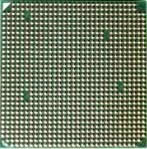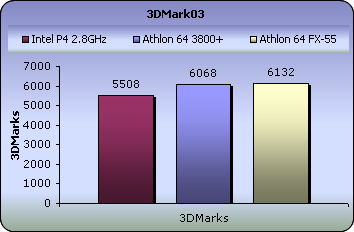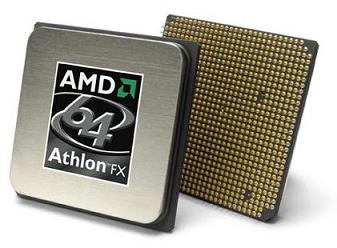1. Introduction
AMD Athlon 64 FX-55 - Page 1
- Introduction
 Last
month we examined the Athlon 64 3800+, a high definition 64-bit state-of-the-art
processor from AMD. Since then, AMD has introduced two more processors. The
first is the Athlon 64 4000+ which is the successor to the 3800+ and the
second,
the Athlon FX-55, which we'll be reviewing here.
Last
month we examined the Athlon 64 3800+, a high definition 64-bit state-of-the-art
processor from AMD. Since then, AMD has introduced two more processors. The
first is the Athlon 64 4000+ which is the successor to the 3800+ and the
second,
the Athlon FX-55, which we'll be reviewing here.
So what is the real difference between the two family lines, Athlon 64 FX
and Athlon 64?

Initially, the difference was quite obvious. The FX processors
used the 940-pin socket type whereas the 64 was made for the 754 socket.
The FX required
the more expensive, yet reliable buffered memory when the 64 could run just
fine with plain unbuffered modules. Also, the FX usually had more L2 cache
memory and
generally ran at higher clock speeds.
However, AMD then introduced us to the 939 socket and having decided
to base all of its processors on this socket, the fine line between the two
families
began to blur. Now
it's
almost impossible to spot the difference. The 4000+ and 3700+ offer 1Mb of
L2 cache and if you compare the two top products from each family, you'll
see that the only thing seperating them is 200MHz clock speed.
AMD's Athlon 64 4000+ is just an FX-53 with a different name!
 |
| Socket 939 |
Actually, there's another not so obvious difference between them. All
Athlon 64 processors ship with their CPU multiplier locked, as opposed
to the FX processors
that are still left unlocked by AMD.
Model Number |
Frequency |
L2 Cache |
Socket Type |
4000+ |
2.4GHz |
1024KB |
939-pin |
3800+ |
2.4GHz |
512KB |
939-pin |
3700+ |
2.4GHz |
1024KB |
754-pin |
3500+ |
2.2GHz |
512KB |
939-pin |
3400+ |
2.4GHz |
512KB |
754-pin |
3200+ |
2.2GHz |
512KB |
754-pin |
3000+ |
2.0GHz |
512KB |
754-pin |
FX-51 |
2.2GHz |
1024KB |
940-pin |
FX-53 |
2.4GHz |
1024KB |
940-pin |
FX-53 |
2.4GHz |
1024KB |
939-pin |
FX-55 |
2.6GHz |
1024KB |
939-pin |
|
Athlon 64 FX processor architecture |
Let's examine the FX-55 features more thoroughly.
2. Specifications
AMD Athlon 64 FX-55+ - Page 2
Let's take a quick preview at some of the features the FX-55 offers us:
|
AMD Athlon 64 FX-55 packaging |
| CPU Name |
AMD Athlon 64 FX-55 |
| Codename |
ClawHammer |
| CPU Core Frequency |
2.60GHz (13x200 with locked multiplier) |
| Built-In antivirus support(SP2 required) |
Yes |
| Simultaneous 32- & 64-bit computing |
Yes |
| L1 Cache (Instruction + Data) |
128KB (64KB + 64KB) |
| L2 Cache |
1024KB |
| HyperTransport |
Yes, one 16x16 link @ 2000 MHz |
| HyperTransport I/O Bandwidth |
Up to 8 GB/s |
| Integrated DDR Memory Controller |
Yes |
| Memory Controller Width |
128-bit |
| Memory Supported |
PC3200, PC2700, PC2100 and PC1600 DDR unbuffered memory |
| Memory Bandwidth |
Up to 6.4 GB/s |
| Total Processor-to-system Bandwidth (HTT plus memory bandwidth) |
Up to 14.4 GB/s |
| Process Technology |
0.13µ, Strained Silicon-on-insulator technology |
| Packaging |
939-pin organic micro PGA |
| Thermal Design Power |
89W |
| Die Size |
144 mm2 |
| Number of Transistors |
Approximately 68.5 million |

The Athlon 64 FX-55 runs by default at a speed of 2.6GHz. That's higher
than any AMD processor we have seen so far. It seems the reason for this extra
boost
in clock speed, originates from the use of strained silicon on the insulator.
Strained silicon works by "straining" the lattice of electrical bonds
that make up the inside of a chip, pulling them apart slightly. In this way,
the
amount of drive current needed to power the chip is reduced, allowing the chip
to run faster.
|
The AMD Athlon 64 FX-55 processor |
The AMD Athlon 64 FX-55 costs approximately $900. The price might sound completely
insane for mainstream users but AMD's FX product line is aiming for "gamers,
prosumers and PC enthusiasts".
3. Test System
AMD Athlon 64 FX-55 - Page 3
Here's a rundown of our testbed used to test the 3800+ processor:
System Specifications:
CPU: AMD Athlon 64 FX-55
Cooler: Zalman CNPS7000A-Cu
Motherboard: A8V Deluxe
Power supply: Levicom 500 Watt
Memory: 2x OCZ DDR-SDRAM PC3200 – 512 MB (dual channel)
VGA: Sapphire 9800pro
Hard Disk Drive: WD800JD 80GB 7200RPM
OS: Windows XP Pro SP2 & Windows XP x64 Edition SP1
Drivers: 4.9 Catalyst
DirectX: v9.0c

Benchmarks & Applications used
- Sisoft Sandra 2004
- Prime95
- PcMark04
- 3DMark03
- CPU-Z
4. Prime95
AMD Athlon 64 FX-55 - Page 4
Prime95
Prime95 is basically a Mersenne prime number discovery program. It's
a great example of Distributed Computing, but it's most loved by overclockers
for its powerful system stress-testing and benchmarking abilities. It can torture-test
your CPU to produce its maximum heat or spit out any errors due to excessive
overclocking. Also, using the blend test, it can consume all your physical memory
and run error-checking tests on your modules to ensure their quality. However,
right now, we're mostly interested in it for its benchmarking capabilities.
Here are the timings for our Athlon 64 FX-55, the 3800+ and an Intel Pentium 4 2.4GHz.(less is better)

You can see the Intel processor prevails and computes the primes much faster
than either of the AMD processors. Even though the FX-55 clock speed is 2.6GHz,
200MHz faster than the Intel CPU, the difference is disappointing. Knowing
Athlons' disadvantage in computational benchmarks we expected at least slightly
a higher
speed from the FX-55.
5. PCMark04
AMD Athlon 64 FX-55 - Page 5
PCMark04
PCMark04 is an application-based benchmark and a premium tool for measuring overall PC performance. It uses portions of real applications instead of including very large applications or using specifically created code. This allows PCMark04 to be a smaller installation as well as to report very accurate results. As far as possible, PCMark04 uses public domain applications whose source code can be freely examined by any user.
PCMark04 includes 4 categorized suites for benchmarking your computer. These
include CPU, Graphics, Memory and a Hard Disk Drive benchmark.

Running the CPU suite benchmark, we obtained the results you can see on
the chart above. According to PCMark04, the FX-55 processor offers 8% higher
performance
than the 3800+.
Let's examine the extended results:
CPU |
AMD Athlon 64
FX-55 |
AMD Athlon 64
3800+ |
File Compression (MB/s) |
3.8 |
3.3 |
File Encryption (MB/s) |
40.3 |
37.2 |
File Uncompression (MB/s) |
31.7 |
28.9 |
Image Processing (MPixels/s) |
16.0 |
14.6 |
Grammar Check (KB/s) |
6.1 |
6.5 |
File Decryption (MB/s) |
80.3 |
74.2 |
Audio Conversion (KB/s) |
3439.8 |
3171.9 |
WMV Video Compression (FPS) |
61.1 |
56.2 |
DivX Video Compression (FPS) |
77.6 |
71.8 |
With the only exception of Grammar Check, where the 3800+ seems to be a bit
faster, the FX-55 produced generally better results.
6. SiSoftware Sandra 2004
AMD Athlon 64 FX-55 - Page 6
SiSoftware Sandra 2004
 SiSoftware
Sandra (the System ANalyzer, Diagnostic and Reporting Assistant) is an information & diagnostic
utility. It should provide most of the information (including undocumented)
you need to know about your hardware, software and other devices, whether
hardware or software.
SiSoftware
Sandra (the System ANalyzer, Diagnostic and Reporting Assistant) is an information & diagnostic
utility. It should provide most of the information (including undocumented)
you need to know about your hardware, software and other devices, whether
hardware or software.
CPU Arithmetic
Sandra's CPU arithmetic benchmark suite uses 2 famous benchmarks (Dhrystone
and Whetstone) for stress testing the processor. Also, it includes a new
version of the Whetstone test that makes use of a processor's SSE2 instructions
to show the performance boost an application might gain should it be optimized
for SSE2. Unfortunately, this does not always represent true real-life performance,
but is useful for comparing the speed of various CPUs.
|
Note:All Intel results are taken as provided by SiSoftware Sandra 2004. |
AMD's Athlon FX-55 seems to be lacking in Dhrystone performance compared
to the Athlon 64 3800+.
CPU Multimedia
This test involves the generation of Mandelbrot Set fractals that are
used to realistically describe and generate natural objects such as mountains
or clouds. By using various multi-media extensions (MMX), 3DNow! and SSE(2/3)
better performance is achieved.

Here the benchmark ran on all Pentiums taking advantage of their
x8 SSE2 instructions for integers and x4 SSE2 for floating points, whereas
on our AMD it could make use of its x4 Enhanced MMX and SSE instructions for
integers.
However it's with floating point calculations that the 3800+ seems to lag
in performance, being placed third.
7. Futuremark 3DMark03
AMD Athlon 64 FX-55 - Page 7
Futuremark 3DMark03
 3DMark
is a widely used and accepted benchmark that stresses the DirectX performance
of a VGA card. For testing the performance of each card we use the 4 game
benchmark 3DMark offers. The first is a DirectX 7 game, the second and the
third use DirectX 8 and the last one stresses graphics in DirectX 9. A very
strong
point of 3DMark is that its VGA card measuring does not require a lot
of CPU power. So the resulting fps are a good reference of a VGA card's rendering
performance.
3DMark
is a widely used and accepted benchmark that stresses the DirectX performance
of a VGA card. For testing the performance of each card we use the 4 game
benchmark 3DMark offers. The first is a DirectX 7 game, the second and the
third use DirectX 8 and the last one stresses graphics in DirectX 9. A very
strong
point of 3DMark is that its VGA card measuring does not require a lot
of CPU power. So the resulting fps are a good reference of a VGA card's rendering
performance.
 |
 |
| GT3 - Troll's Lair |
GT4 - Mother Nature |
++On the following chart you can see the computed 3DMark03 points using our
Sapphire 9800 pro Ultimate card on three different processors.

Performance with the FX-55 is slightly improved compared to
the 3800+, and both processors left the Intel 2.8GHz behind by 500 3dmarks.
8. Half Life 2 VST
AMD Athlon 64 FX-55 - Page 8
Half Life 2 VST
Half life 2 is no doubt the most anticipated pc game of
all times. Gamers having the excellence of Half Life 1 in mind,
as well as the remarkable E3 demo preview, have been anxiously waiting
for the much delayed release of HL2.
Physics - From pebbles to water to 2-ton trucks respond as expected, as they obey the laws of mass, friction, gravity, and buoyancy.

Graphics - Source's shader-based renderer, like the one
used at Pixar to create movies such as Toy Story® and Monster's, Inc.®,
creates the most beautiful and realistic environments ever seen in a video
game.
AI - Neither friends nor enemies charge blindly into the fray. They can assess threats, navigate tricky terrain, and fashion weapons from whatever is at hand.
 To
measure performance we used the Video Stress Test (VST) that is available
in the CounterStrike:Source beta available through Steam. For measuring
CPU performance, we set all the details to the lowest level and set the
resolution to 640x480.
To
measure performance we used the Video Stress Test (VST) that is available
in the CounterStrike:Source beta available through Steam. For measuring
CPU performance, we set all the details to the lowest level and set the
resolution to 640x480.

With almost double the performance of an Intel P4 2.8GHz,
the FX-55 is certain to bring the best out of all modern games. In the Half
Life 2 Video Stress test, it almost reached the excellent 200 frames per
second.
9. Conclusion
AMD Athlon 64 FX-55 - Page 9
Conclusion
The FX-55 is top of AMD's 64-bit family line and probably the best processor
available on the market right now. Even though it still lacks in application
performance compared to Intel processors, its advantage in games more than
makes up for it.

The price of the Athlon FX-55 is its major drawback for the regular
computer user. Even though the FX-55 costs approximately $900, which is $200
cheaper than the Intel 3.4GHz Extreme Edition, it is still overpriced compared
to its
predecessors from the FX family.
Pros
-Excellent game performance
-Cheaper than the Intel P4 Extreme Edition
Cons
-Unsatisfactory computational performance
-Unaffordable by mid-range computer users